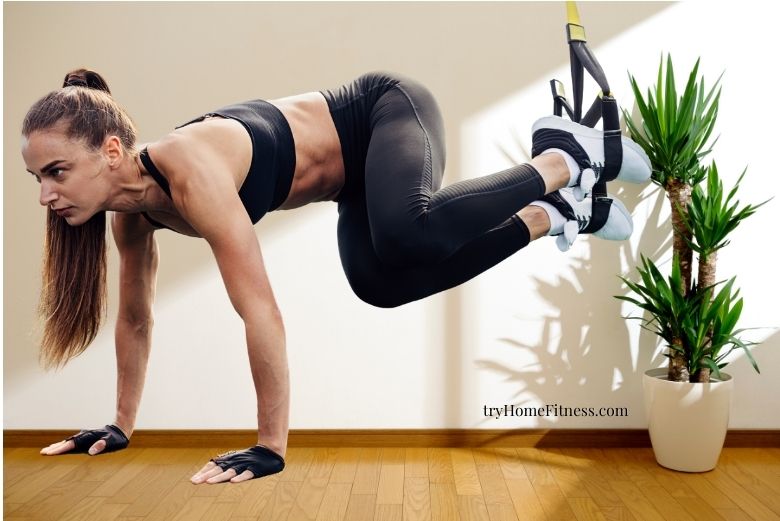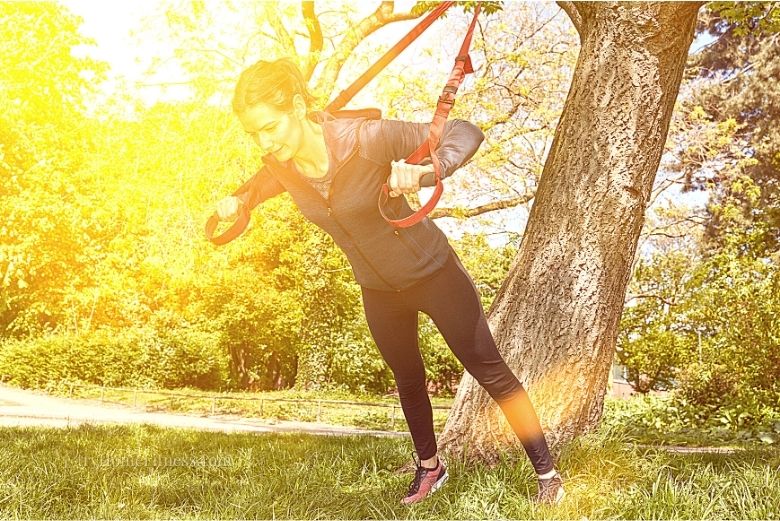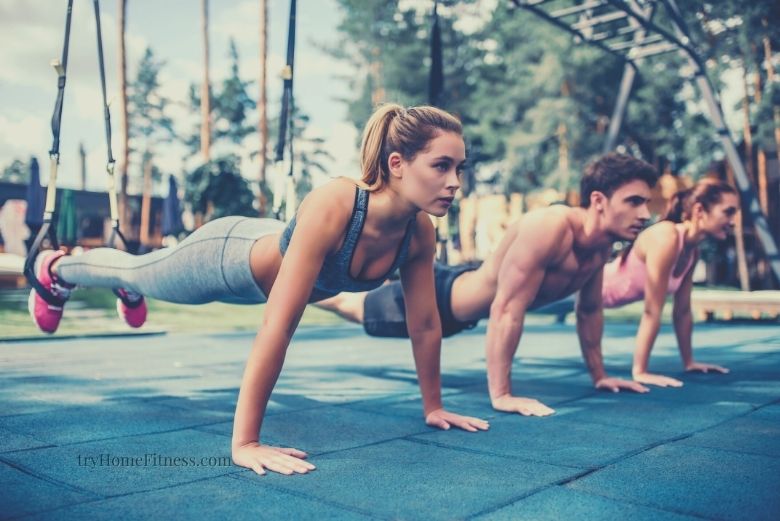Suspension training is often referred to as TRX, which stands for ‘Total Resistance eXercise’, a term coined by Randy Hetrick, a former US Navy seal. I’ll be referring to both suspension and TRX training throughout this guide as meaning the same.
As a young mom, working out from home makes my life easier. I love how easy it is to effectively use suspension trainers for a total body workout. They’re not bulky and I can use them almost anywhere.
With some help from my partner, a military serviceman, I have learned a lot more than I knew from going to TRX classes some time ago. I am not an expert in biomechanics, however, the following may help if you’re looking to get into suspension training exercise.
We’ll come on to the suspension training benefits a little later but first, what even is suspension training or TRX?
Contents
So, What Is Suspension Training?
Suspension trainers consist of flexible, strong straps with a pair of handles or rings and a point of anchor that attaches to a firm surface.
Put simply, suspension trainers are the different kinds of equipment used for TRX or suspension training.
Suspension training is a form of calisthenics, one which enables strength training using your own body weight.
If you have ever done push-ups, squats, or crunches, you are already familiar with strength training. Basically, strength training exercises make you move your body against a resisting force using equipment or body weight. For example, squats engage your legs to resist your body weight, activating them to make them stronger.
Suspension training adds another dimension. It’s a type of strength exercise performed using your bodyweight and supported from an anchor point.
The anchor point attaches to straps to form a resistance against gravity and build strength, balance, and flexibility.
Being a fan of suspension trainers I did a good deal of research and found what we believe to be the 5 best suspension trainers.
Suspension Training Benefits
Military personnel know the benefits of suspension training all too well because it is a regular part of their training. For them, it was efficacy and compactness. Some of the following benefits can become self-evident after only a short time as I was pleasantly surprised to discover especially with the first on my list of suspension training benefits.
1. Total Core Engagement
Suspension training exercises tend to involve the whole body, including your abs, pelvis, and back muscles, but most of all they strengthen the core.
I generally dislike core targeted exercises – I think many people do – they make me feel nauseated and I lose motivation as I often can’t do them to any degree without getting back pain. Take crunches for instance – please!
Suspension training can make core workouts more enjoyable as we’ll find out in the example exercises below.
These exercises ensure that your core, which is the source of your body’s power, gets strong. You can easily target your core and get an intense workout with suspension training.
And it’s not just getting firm abs, not just the “6-pack” – everyone’s favorite fitness goal. There are a whole “rack” of interconnected and very important core muscles including the pelvic floor muscles, obliques, transverse abs, multifidus, erector spinae and more.
All the core muscles stabilize the lower body providing a solid platform for our everyday physical functioning. The natural balance that a strong core provides helps allay back pain, joint pain in hips and knees, and even neck pain.



In strong core muscles, we trust our everyday movement which becomes more important as we get older.
Part suspending your body at all angles and configurations is a gentle but effective way of activating all the muscles of the core.
2. During & After Pregnancy
Although I fully understand the need to be as strong and fit as possible whilst getting fatter and fatter throughout my pregnancy I wasn’t fully appreciative of the suspension training benefits as a means of maintaining my strength.
I can understand how suspension trainers can help to build the strength needed pre-birth without putting stress on the body where it’s not needed. This form of exercise allows you to train even with a strangely growing body.
Certainly, after our little loves joined our lives I gave suspension trainers a go and soon found a routine that complimented my day and to my pleasant surprise, I found the return of firm abs was the first benefit I noticed.
Suspension trainers are a big plus for postpartum women who have lost abdominal strength and certain pregnancy-related hormones in the blood can affect balance – we’ll come onto the balance as a benefit next.
3. Improved Balance and Coordination
Suspension training exercises are unstable which sounds bad but it’s a good thing. Your equilibrium is not steady during exercise. This is because there is no firm surface on which your body can balance.
Consequently, the body activates as many muscle groups as possible, both minor and major. Muscles are constantly activating to compensate for the small shifts in the body and brain trying to find the center of gravity.
In this way, suspension training reaches parts of the body that other exercises can’t reach.
4. Improves Cardio Endurance
Suspension training programs are largely built around interval sessions made up of time or number of repetitions. This means that the cardiovascular system is exercised improving stamina and endurance.
A program can be designed that works on strength and cardio training side by side or the two disciplines can be done in separate sessions.
5. A Large Variety of Exercises To Choose From
You can use the two-strap equipment to perform a boat load of exercises and for different parts of the body. Although the equipment appears simple, – well it is – due to it’s non-rigid nature and the brilliant flexibility of the human body, practically all muscle groups can be activated.
All you need is the right instructions, a bit of adjustment to the straps and the height of the anchor point.
This can either be push movements that engage more of your core, chest, and shoulders; or pull movements, which are perfect for your lower body, back, and biceps. There are some examples below.
6. Easy on The Joints
This is a form of strength training that doesn’t over-stress the joints like lifting weights can. There is no repetitious pounding of limbs.
With suspension training, you are using your own body weight as resistance instead of the weight of metal.
Much of the time during TRX exercises you are partly suspended. The movements are fluid and no extra stress is put on the joints making it suitable for all ages and abilities. Particularly the older adult and anyone recovering from injury.
7. Suspension Training is Scalable
The straps are adjustable, allowing you to regulate the intensity of the exercises, which is especially good if you’re just starting out.
And the exercises can be simple to start with but can get as crazy difficult as you like. You only need a little balance, which should improve a lot after a few sessions. It’ll help to have a light warm-up before you begin each suspension training session.
Because of the nature of the 360°, 3-dimensional positioning of the straps in relation to your body virtually any degree of difficulty can be attained. That also means that someone with little physical strength or fitness, in general, can begin to see improvements quite quickly.
8. TRX Training is Fun
This one might sound a little trite but suspension training is a lot easier and much more fun than it may sound.
Once you get familiar with the range of exercises it can take a lot less time than you may think before you start working hard. One of the best suspension training benefits is that it helps you achieve fitness goals quickly, ensuring that you want to come back for more.
So seeing rewards with TRX training quickly is a motivating factor to continue on with the program. Although it’s fair to say that getting the hang of all the possible exercises, and there are 100s of possibilities, may be daunting at first.
But persevere and get to the “having fun” stage.
Is Suspension Training Right for You?
Suspension training can be pretty intense if you are starting out from scratch with a workout routine. Improvements will be quicker after your initial balance gets better enabling you to better control and support your body’s weight against the force of gravity.
However, regardless of age, any reasonably fit-ish person can perform suspension training exercises once they know how to handle and adjust their suspension trainers.
Many studies have been carried out that show the suspension training benefits for health across different age groups and abilities.
So, YES!
How Suspension Training Works
As you already know by now, suspension training uses specially designed straps referred to as suspension trainers, which anchor onto a central point, usually above a person’s head.
Once secured, you will firmly hold the suspension trainers with your hand or wear them on your feet. While setting up your equipment at home, you should ensure that you anchor it on a strong base, such as a door frame or a strong tree branch.



The main point here is to ensure that your anchor is strong enough to support your weight and strength without undue movement.
You will then suspend yourself either from the feet or hands to create the resistant force, which will make you use your core and muscle strength to gain stability. By doing so repeatedly, you will start to gain the benefits of suspension training.
Apart from the location of the anchor points there are 2 ways of suspension. There is the regular single anchor point which gives you the advantage of moving about the point in 360 degrees.
Then there is the dual anchor points which gives a variable width allowing a bigger range of strength movements.
They both have their merits but generally, a single rotational anchor point is best for cardio or circuit training and the dual point anchor is best if you’re concentrating on strength training only.
Suspension Training Exercises
There are countless home-based suspension training exercises worth trying. Or indeed ones that can be done outside in a local park or garden.
They can be made as tough as you like. I was going to say as easy as you like too, but done properly with the right form, TRX training increases the gravity effect of your bodyweight. So all-in-all these exercises are tougher than doing something similar without the suspension.
Here are some good examples. The first 3 are less demanding and suitable if staring out.
Squats
Squats improve strength and build lower body muscles but using a suspension trainer, you can execute compound exercises that activate other parts like this Incline Squat.
This is a great example of a TRX exercise that can easily be modified for beginners and the less fit by using the straps to help raise and lower the body. Or, in this case, change the angle of incline.
Bridge
For this exercise, lay on your back beneath the suspension trainer with your feet placed in the handles. Keep your hands flat on the ground as you lift your hips in the air and back down. Keep your legs bent at 90 degrees. Push your feet down more rather than forward.
This is another relatively easy one for starters. To get the most out of the glute bridge, on coming back down don’t pause at the ground.
This movement engages your core and upper legs but I also find this TRX exercise is great for releasing pressure in the back. Quite often my first few glute bridge movements will resound with light the cracking of my spine. But, I like it.
Oh! don’t forget a gym mat of your choice. My preference is a thick .6 inch mat.
Pike
The pike gets right at your upper body and the core. For this exercise, you will need to fix your feet on the handles while facing down towards the floor. In a half plank, body supported off the ground with your elbows, pull your legs inward toward your core and back out. So your bum will rise and fall. As you come down slide forward on your elbows for that extra burn.
This is good for beginners especially as they’ll quickly start to see a strengthening of the core.
Push-ups
Instead of placing your hands on the ground, they remain on the suspension trainer just off ground level. At the same time, your body stays in the regular push-up position. Doing a push up by pushing against the handles will have the same benefits on the arms and chest but with the further advantage of activating the minor muscles when counteracting the instability of the movement.
Alternatively your arms stay on the ground and it’s your legs that are suspended for this Atomic Push Ups.
Mountain Climbers or Running man
I love this one. It’s like mountain climbers done without suspension trainers but this is really fun with the straps.
You will need to fix your feet on the handles while facing the ground. With your hands lifting your body off the ground, pull up one leg after the other as if you are running on a track or mountain climbing (very quickly). In the process, you will be working out your legs, arms, abs, and core.
Do it slow and steady and it’s mountain climbers that will target more the arms and core. Do it hard and fast and it’s running man for attention going to the legs and core. I like it slow and steady but that’s another issue! Either way it’s tough but effective.
Sit-Ups – Assisted Crunch
I hate sit-ups or crunches – I think I may have mentioned that – they always used to affect my back. This is different though, as the straps add assistance so these are perfect for beginners or for those, like me, that want some back protection.
Like the standard sit-ups, lay flat on your back or make a slight arch with your knees off the ground. Keep your hands on the handle and pull your body repeatedly off the ground and back down. These sit-ups will work out your core, abs, and upper body.
And Finally
As a workout-at-home mom, I have developed an undeniable love for suspension training and it was partly due to the quick rewards that I could feel and see.
Suspension training benefits are clear:
- Improved core strength – daily functional fitness, how important is that?
- Improves balance & coordination – important for us all especially in aging
- Easy on the joints – ideal for older adults and recovering athletes
- Cardio fitness – healthy heart and respiratory system
- Variety of workouts – never get bored
- Scalable – start off “not fit” end up, fit

